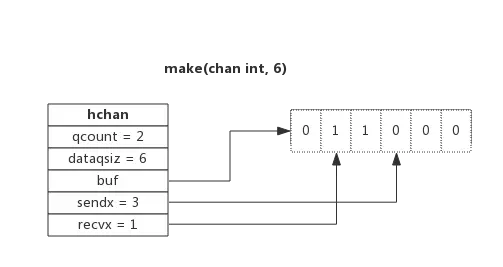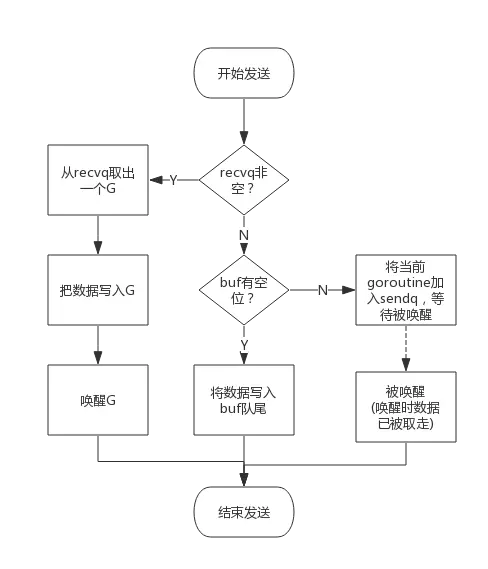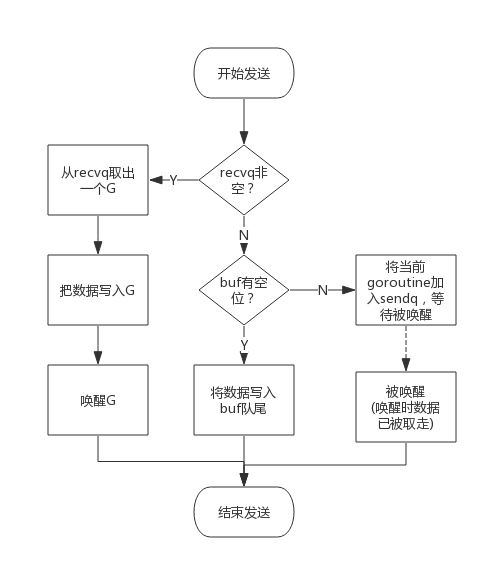Channel作为Go CSP的重要组成部分
在传统的编程语言中,并发编程模型是基于线程和内存同步访问控制。
而CSP是一种新的并发编程模型,CSP的并发哲学:
Do not communicate by sharing memory; instead, share memory by communicating.
不要通过共享内存来通信,而要通过通信来实现内存共享。
Go 是第一个将 CSP 的这些思想引入,并且发扬光大的语言。
Go 的并发编程(CSP)的模型则用 goroutine 和 channel 来替代。
channel 提供了一种通信机制,通过它,一个 goroutine 可以向另一 goroutine 发送消息,channel内部有mutex 用于内存同步访问控制。
chan数据结构
src/runtime/chan.go:hchan定义了channel的数据结构:
type hchan struct {
qcount uint // 当前队列中剩余元素个数
dataqsiz uint // 环形队列长度,即可以存放的元素个数
buf unsafe.Pointer // 环形队列指针
elemsize uint16 // 每个元素的大小
closed uint32 // 标识关闭状态
elemtype *_type // 元素类型
sendx uint // 队列下标,指示元素写入时存放到队列中的位置
recvx uint // 队列下标,指示元素从队列的该位置读出
recvq waitq // 等待读消息的goroutine队列
sendq waitq // 等待写消息的goroutine队列
lock mutex // 互斥锁,chan不允许并发读写
}
属性解析
从数据结构可以看出channel由队列、类型信息、goroutine等待队列组成,下面分别说明其原理。
buf 指向底层环形队列,只有缓冲型的 channel 才有。
sendx,recvx 均指向底层环形队列,表示当前可以发送和接收的元素位置索引值(相对于底层数组)。
sendq,recvq 分别表示被阻塞的 goroutine,这些 goroutine 由于尝试向channel发送数据 或从 channel 读取数据而被阻塞。
waitq 是 sudog 的一个双向链表,而 sudog 实际上是对 goroutine 的一个封装:
type waitq struct {
first *sudog
last *sudog
}
type sudog struct {
// The following fields are protected by the hchan.lock of the
// channel this sudog is blocking on. shrinkstack depends on
// this for sudogs involved in channel ops.
g *g
selectdone *uint32 // CAS to 1 to win select race (may point to stack)
next *sudog
prev *sudog
elem unsafe.Pointer // data element (may point to stack)
// The following fields are never accessed concurrently.
// For channels, waitlink is only accessed by g.
// For semaphores, all fields (including the ones above)
// are only accessed when holding a semaRoot lock.
acquiretime int64
releasetime int64
ticket uint32
parent *sudog // semaRoot binary tree
waitlink *sudog // g.waiting list or semaRoot
waittail *sudog // semaRoot
c *hchan // channel
}
一个channel同时仅允许被一个goroutine读写,lock 用来保证每个读 channel 或写 channel 的操作都是原子的。
一个channel只能传递一种类型的值,类型信息存储在hchan数据结构中。
elemtype代表类型,用于数据传递过程中的赋值;
elemsize代表类型大小,用于在buf中定位元素位置。
环形队列
chan内部实现了一个环形队列作为其缓冲区,队列的长度是创建chan时指定的。
下图展示了一个可缓存6个整型类型元素的channel示意图:

dataqsiz指示了队列长度为6,即可缓存6个元素;
buf指向队列的内存,队列中还剩余两个元素;
qcount表示队列中还有两个元素;
sendx指示后续写入的数据存储的位置,取值[0, 6);
recvx指示从该位置读取数据, 取值[0, 6);
创建channel
使用make创建channel
// 无缓冲通道
ch1 := make(chan int)
// 有缓冲通道
ch2 := make(chan int, 10)
创建channel的过程实际上是初始化hchan结构。其中类型信息和缓冲区长度由make语句传入,buf的大小则与元素大小和缓冲区长度共同决定。
源码
func makechan(t *chantype, size int64) *hchan {
elem := t.elem
// compiler checks this but be safe.
if elem.size >= 1<<16 {
throw("makechan: invalid channel element type")
}
if hchanSize%maxAlign != 0 || elem.align > maxAlign {
throw("makechan: bad alignment")
}
if size < 0 || int64(uintptr(size)) != size || (elem.size > 0 && uintptr(size) > (_MaxMem-hchanSize)/elem.size) {
panic(plainError("makechan: size out of range"))
}
var c *hchan
if elem.kind&kindNoPointers != 0 || size == 0 {
// case 1: channel 不含有指针
// case 2: size == 0,即无缓冲 channel
// Allocate memory in one call.
// Hchan does not contain pointers interesting for GC in this case:
// buf points into the same allocation, elemtype is persistent.
// SudoG's are referenced from their owning thread so they can't be collected.
// TODO(dvyukov,rlh): Rethink when collector can move allocated objects.
// 在堆上分配连续的空间用作 channel
c = (*hchan)(mallocgc(hchanSize+uintptr(size)*elem.size, nil, true))
if size > 0 && elem.size != 0 {
c.buf = add(unsafe.Pointer(c), hchanSize)
} else {
// race detector uses this location for synchronization
// Also prevents us from pointing beyond the allocation (see issue 9401).
c.buf = unsafe.Pointer(c)
}
} else {
// 有缓冲 channel 初始化
c = new(hchan)
// 堆上分配 buf 内存
c.buf = newarray(elem, int(size))
}
c.elemsize = uint16(elem.size)
c.elemtype = elem
c.dataqsiz = uint(size)
if debugChan {
print("makechan: chan=", c, "; elemsize=", elem.size, "; elemalg=", elem.alg, "; dataqsiz=", size, "
")
}
return c
}
channel特性
- 关闭一个未初始化(nil) 的 channel 会产生 panic;
- 重复关闭同一个 channel 会产生 panic;
- 向一个已关闭的 channel 中发送消息会产生 panic;
- 从已关闭的 channel 读取消息不会产生 panic,且能读出 channel 中还未被读取的消息,若消息均已读出,则会读到类型的零值。从一个已关闭的 channel 中读取消息永远不会阻塞,并且会返回一个为 false 的 ok-idiom,可以用它来判断 channel 是否关闭;
- 关闭 channel 会产生一个广播机制,所有向 channel 读取消息的 goroutine 都会收到消息。
- 从无缓存的 channel 中读取消息会阻塞,直到有 goroutine 向该 channel 中发送消息;
- 向无缓存的 channel 中发送消息也会阻塞,直到有 goroutine 从 channel 中读取消息。
- 有缓存的 channel 当缓存未满时,向 channel 中发送消息时不会阻塞,当缓存满时,发送操作将被阻塞,直到有其他 goroutine 从中读取消息;
- 有缓存的 channel 当消息不为空时,读取channel中消息不会出现阻塞,当 channel 为空时,读取操作会造成阻塞,直到有 goroutine 向 channel 中写入消息。
向channel写数据
向一个channel中写数据简单过程如下:
- 如果等待接收队列recvq不为空,说明缓冲区中没有数据或者没有缓冲区,此时直接从recvq取出G,并把数据写入,最后把该G唤醒,结束发送过程;
- 如果缓冲区中有空余位置,将数据写入缓冲区,结束发送过程;
- 如果缓冲区中没有空余位置,将待发送数据写入G,将当前G加入sendq,进入睡眠,等待被读goroutine唤醒;

源码
// entry point for c <- x from compiled code
//go:nosplit
func chansend1(c *hchan, elem unsafe.Pointer) {
chansend(c, elem, true, getcallerpc(unsafe.Pointer(&c)))
}
/*
* generic single channel send/recv
* If block is not nil,
* then the protocol will not
* sleep but return if it could
* not complete.
*
* sleep can wake up with g.param == nil
* when a channel involved in the sleep has
* been closed. it is easiest to loop and re-run
* the operation; we'll see that it's now closed.
*/
func chansend(c *hchan, ep unsafe.Pointer, block bool, callerpc uintptr) bool {
//当 channel 未初始化或为 nil 时,向其中发送数据将会永久阻塞
if c == nil {
if !block {
return false
}
// gopark 会使当前 goroutine 休眠,并通过 unlockf 唤醒,但是此时传入的 unlockf 为 nil, 因此,goroutine 会一直休眠
gopark(nil, nil, "chan send (nil chan)", traceEvGoStop, 2)
throw("unreachable")
}
if debugChan {
print("chansend: chan=", c, "
")
}
if raceenabled {
racereadpc(unsafe.Pointer(c), callerpc, funcPC(chansend))
}
// Fast path: check for failed non-blocking operation without acquiring the lock.
//
// After observing that the channel is not closed, we observe that the channel is
// not ready for sending. Each of these observations is a single word-sized read
// (first c.closed and second c.recvq.first or c.qcount depending on kind of channel).
// Because a closed channel cannot transition from 'ready for sending' to
// 'not ready for sending', even if the channel is closed between the two observations,
// they imply a moment between the two when the channel was both not yet closed
// and not ready for sending. We behave as if we observed the channel at that moment,
// and report that the send cannot proceed.
//
// It is okay if the reads are reordered here: if we observe that the channel is not
// ready for sending and then observe that it is not closed, that implies that the
// channel wasn't closed during the first observation.
if !block && c.closed == 0 && ((c.dataqsiz == 0 && c.recvq.first == nil) ||
(c.dataqsiz > 0 && c.qcount == c.dataqsiz)) {
return false
}
var t0 int64
if blockprofilerate > 0 {
t0 = cputicks()
}
// 获取同步锁
lock(&c.lock)
//向已经关闭的 channel 发送消息会产生 panic
if c.closed != 0 {
unlock(&c.lock)
panic(plainError("send on closed channel"))
}
// CASE1: 当有 goroutine 在 recv 队列上等待时,跳过缓存队列,将消息直接发给 reciever goroutine
if sg := c.recvq.dequeue(); sg != nil {
// Found a waiting receiver. We pass the value we want to send
// directly to the receiver, bypassing the channel buffer (if any).
send(c, sg, ep, func() { unlock(&c.lock) }, 3)
return true
}
// CASE2: 缓存队列未满,则将消息复制到缓存队列上
if c.qcount < c.dataqsiz {
// Space is available in the channel buffer. Enqueue the element to send.
qp := chanbuf(c, c.sendx)
if raceenabled {
raceacquire(qp)
racerelease(qp)
}
typedmemmove(c.elemtype, qp, ep)
c.sendx++
if c.sendx == c.dataqsiz {
c.sendx = 0
}
c.qcount++
unlock(&c.lock)
return true
}
if !block {
unlock(&c.lock)
return false
}
// CASE3: 缓存队列已满,将goroutine 加入 send 队列
// 初始化 sudog
// Block on the channel. Some receiver will complete our operation for us.
gp := getg()
mysg := acquireSudog()
mysg.releasetime = 0
if t0 != 0 {
mysg.releasetime = -1
}
// No stack splits between assigning elem and enqueuing mysg
// on gp.waiting where copystack can find it.
mysg.elem = ep
mysg.waitlink = nil
mysg.g = gp
mysg.selectdone = nil
mysg.c = c
gp.waiting = mysg
gp.param = nil
// 加入sendq队列
c.sendq.enqueue(mysg)
// 休眠
goparkunlock(&c.lock, "chan send", traceEvGoBlockSend, 3)
// 唤醒 goroutine
// someone woke us up.
if mysg != gp.waiting {
throw("G waiting list is corrupted")
}
gp.waiting = nil
if gp.param == nil {
if c.closed == 0 {
throw("chansend: spurious wakeup")
}
panic(plainError("send on closed channel"))
}
gp.param = nil
if mysg.releasetime > 0 {
blockevent(mysg.releasetime-t0, 2)
}
mysg.c = nil
releaseSudog(mysg)
return true
}
从channel读数据
向一个channel中写数据简单过程如下:
- 如果等待接收队列recvq不为空,说明缓冲区中没有数据或者没有缓冲区,此时直接从recvq取出G,并把数据写入,最后把该G唤醒,结束发送过程;
- 如果缓冲区中有空余位置,将数据写入缓冲区,结束发送过程;
- 如果缓冲区中没有空余位置,将待发送数据写入G,将当前G加入sendq,进入睡眠,等待被读goroutine唤醒;
简单流程图如下:
源码
接收操作有两种写法,一种带 "ok",反应 channel 是否关闭;一种不带 "ok",这种写法,当接收到相应类型的零值时无法知道是真实的发送者发送过来的值,还是 channel 被关闭后,返回给接收者的默认类型的零值。两种写法,都有各自的应用场景。
// entry points for <- c from compiled code
func chanrecv1(c *hchan, elem unsafe.Pointer) {
chanrecv(c, elem, true)
}
func chanrecv2(c *hchan, elem unsafe.Pointer) (received bool) {
_, received = chanrecv(c, elem, true)
return
}
chanrecv1 函数处理不带 "ok" 的情形,chanrecv2 则通过返回 "received" 这个字段来反应 channel 是否被关闭。接收值则比较特殊,会“放到”参数 elem 所指向的地址了,这很像 C/C++ 里的写法。如果代码里忽略了接收值,这里的 elem 为 nil。
无论如何,最终转向了 chanrecv 函数:
// 位于 src/runtime/chan.go
// chanrecv 函数接收 channel c 的元素并将其写入 ep 所指向的内存地址。
// 如果 ep 是 nil,说明忽略了接收值。
// 如果 block == false,即非阻塞型接收,在没有数据可接收的情况下,返回 (false, false)
// 否则,如果 c 处于关闭状态,将 ep 指向的地址清零,返回 (true, false)
// 否则,用返回值填充 ep 指向的内存地址。返回 (true, true)
// 如果 ep 非空,则应该指向堆或者函数调用者的栈
func chanrecv(c *hchan, ep unsafe.Pointer, block bool) (selected, received bool) {
// 省略 debug 内容 …………
// 如果是一个 nil 的 channel
if c == nil {
// 如果不阻塞,直接返回 (false, false)
if !block {
return
}
// 否则,接收一个 nil 的 channel,goroutine 挂起
gopark(nil, nil, "chan receive (nil chan)", traceEvGoStop, 2)
// 不会执行到这里
throw("unreachable")
}
// 在非阻塞模式下,快速检测到失败,不用获取锁,快速返回
// 当我们观察到 channel 没准备好接收:
// 1. 非缓冲型,等待发送列队 sendq 里没有 goroutine 在等待
// 2. 缓冲型,但 buf 里没有元素
// 之后,又观察到 closed == 0,即 channel 未关闭。
// 因为 channel 不可能被重复打开,所以前一个观测的时候 channel 也是未关闭的,
// 因此在这种情况下可以直接宣布接收失败,返回 (false, false)
if !block && (c.dataqsiz == 0 && c.sendq.first == nil ||
c.dataqsiz > 0 && atomic.Loaduint(&c.qcount) == 0) &&
atomic.Load(&c.closed) == 0 {
return
}
var t0 int64
if blockprofilerate > 0 {
t0 = cputicks()
}
// 加锁
lock(&c.lock)
// channel 已关闭,并且循环数组 buf 里没有元素
// 这里可以处理非缓冲型关闭 和 缓冲型关闭但 buf 无元素的情况
// 也就是说即使是关闭状态,但在缓冲型的 channel,
// buf 里有元素的情况下还能接收到元素
if c.closed != 0 && c.qcount == 0 {
if raceenabled {
raceacquire(unsafe.Pointer(c))
}
// 解锁
unlock(&c.lock)
if ep != nil {
// 从一个已关闭的 channel 执行接收操作,且未忽略返回值
// 那么接收的值将是一个该类型的零值
// typedmemclr 根据类型清理相应地址的内存
typedmemclr(c.elemtype, ep)
}
// 从一个已关闭的 channel 接收,selected 会返回true
return true, false
}
// 等待发送队列里有 goroutine 存在,说明 buf 是满的
// 这有可能是:
// 1. 非缓冲型的 channel
// 2. 缓冲型的 channel,但 buf 满了
// 针对 1,直接进行内存拷贝(从 sender goroutine -> receiver goroutine)
// 针对 2,接收到循环数组头部的元素,并将发送者的元素放到循环数组尾部
if sg := c.sendq.dequeue(); sg != nil {
// Found a waiting sender. If buffer is size 0, receive value
// directly from sender. Otherwise, receive from head of queue
// and add sender's value to the tail of the queue (both map to
// the same buffer slot because the queue is full).
recv(c, sg, ep, func() { unlock(&c.lock) }, 3)
return true, true
}
// 缓冲型,buf 里有元素,可以正常接收
if c.qcount > 0 {
// 直接从循环数组里找到要接收的元素
qp := chanbuf(c, c.recvx)
// …………
// 代码里,没有忽略要接收的值,不是 "<- ch",而是 "val <- ch",ep 指向 val
if ep != nil {
typedmemmove(c.elemtype, ep, qp)
}
// 清理掉循环数组里相应位置的值
typedmemclr(c.elemtype, qp)
// 接收游标向前移动
c.recvx++
// 接收游标归零
if c.recvx == c.dataqsiz {
c.recvx = 0
}
// buf 数组里的元素个数减 1
c.qcount--
// 解锁
unlock(&c.lock)
return true, true
}
if !block {
// 非阻塞接收,解锁。selected 返回 false,因为没有接收到值
unlock(&c.lock)
return false, false
}
// 接下来就是要被阻塞的情况了
// 构造一个 sudog
gp := getg()
mysg := acquireSudog()
mysg.releasetime = 0
if t0 != 0 {
mysg.releasetime = -1
}
// 待接收数据的地址保存下来
mysg.elem = ep
mysg.waitlink = nil
gp.waiting = mysg
mysg.g = gp
mysg.selectdone = nil
mysg.c = c
gp.param = nil
// 进入channel 的等待接收队列
c.recvq.enqueue(mysg)
// 将当前 goroutine 挂起
goparkunlock(&c.lock, "chan receive", traceEvGoBlockRecv, 3)
// 被唤醒了,接着从这里继续执行一些扫尾工作
if mysg != gp.waiting {
throw("G waiting list is corrupted")
}
gp.waiting = nil
if mysg.releasetime > 0 {
blockevent(mysg.releasetime-t0, 2)
}
closed := gp.param == nil
gp.param = nil
mysg.c = nil
releaseSudog(mysg)
return true, !closed
}
关闭channel
func closechan(c *hchan) {
// 关闭一个 nil channel,panic
if c == nil {
panic(plainError("close of nil channel"))
}
// 上锁
lock(&c.lock)
// 如果 channel 已经关闭
if c.closed != 0 {
unlock(&c.lock)
// panic
panic(plainError("close of closed channel"))
}
// …………
// 修改关闭状态
c.closed = 1
var glist *g
// 将 channel 所有等待接收队列的里 sudog 释放
for {
// 从接收队列里出队一个 sudog
sg := c.recvq.dequeue()
// 出队完毕,跳出循环
if sg == nil {
break
}
// 如果 elem 不为空,说明此 receiver 未忽略接收数据
// 给它赋一个相应类型的零值
if sg.elem != nil {
typedmemclr(c.elemtype, sg.elem)
sg.elem = nil
}
if sg.releasetime != 0 {
sg.releasetime = cputicks()
}
// 取出 goroutine
gp := sg.g
gp.param = nil
if raceenabled {
raceacquireg(gp, unsafe.Pointer(c))
}
// 相连,形成链表
gp.schedlink.set(glist)
glist = gp
}
// 将 channel 等待发送队列里的 sudog 释放
// 如果存在,这些 goroutine 将会 panic
for {
// 从发送队列里出队一个 sudog
sg := c.sendq.dequeue()
if sg == nil {
break
}
// 发送者会 panic
sg.elem = nil
if sg.releasetime != 0 {
sg.releasetime = cputicks()
}
gp := sg.g
gp.param = nil
if raceenabled {
raceacquireg(gp, unsafe.Pointer(c))
}
// 形成链表
gp.schedlink.set(glist)
glist = gp
}
// 解锁
unlock(&c.lock)
// Ready all Gs now that we've dropped the channel lock.
// 遍历链表
for glist != nil {
// 取最后一个
gp := glist
// 向前走一步,下一个唤醒的 g
glist = glist.schedlink.ptr()
gp.schedlink = 0
// 唤醒相应 goroutine
goready(gp, 3)
}
}
refer: